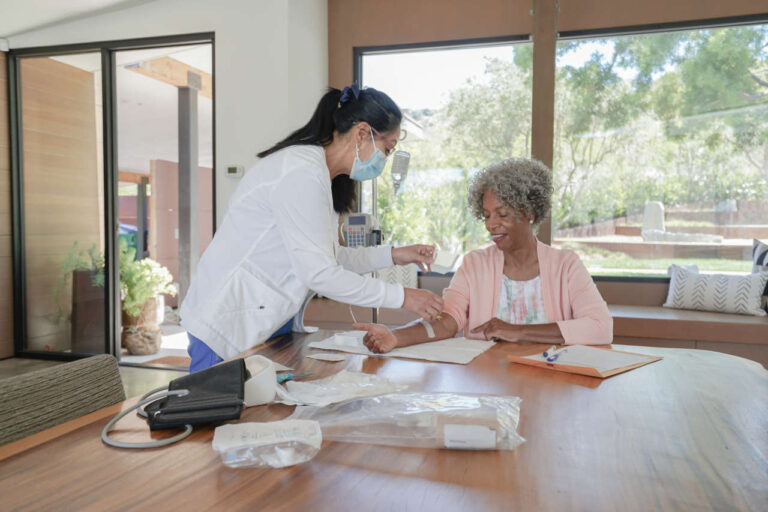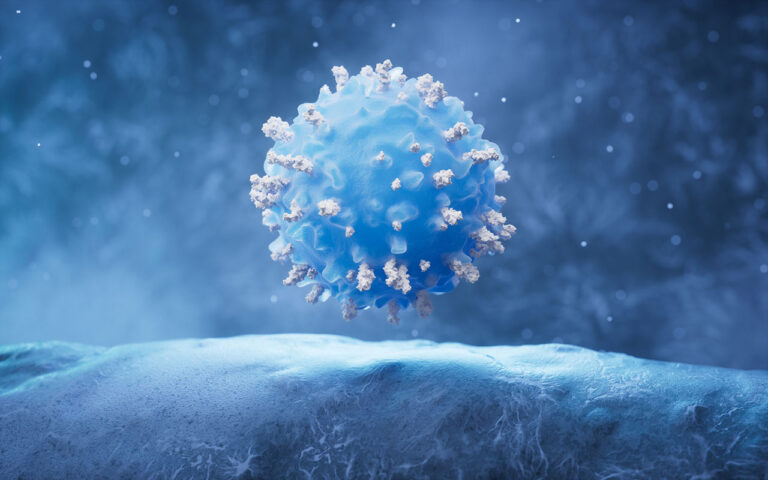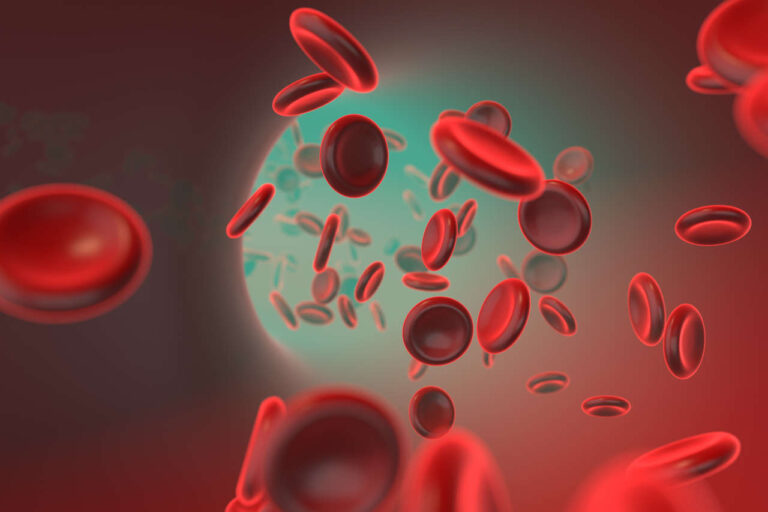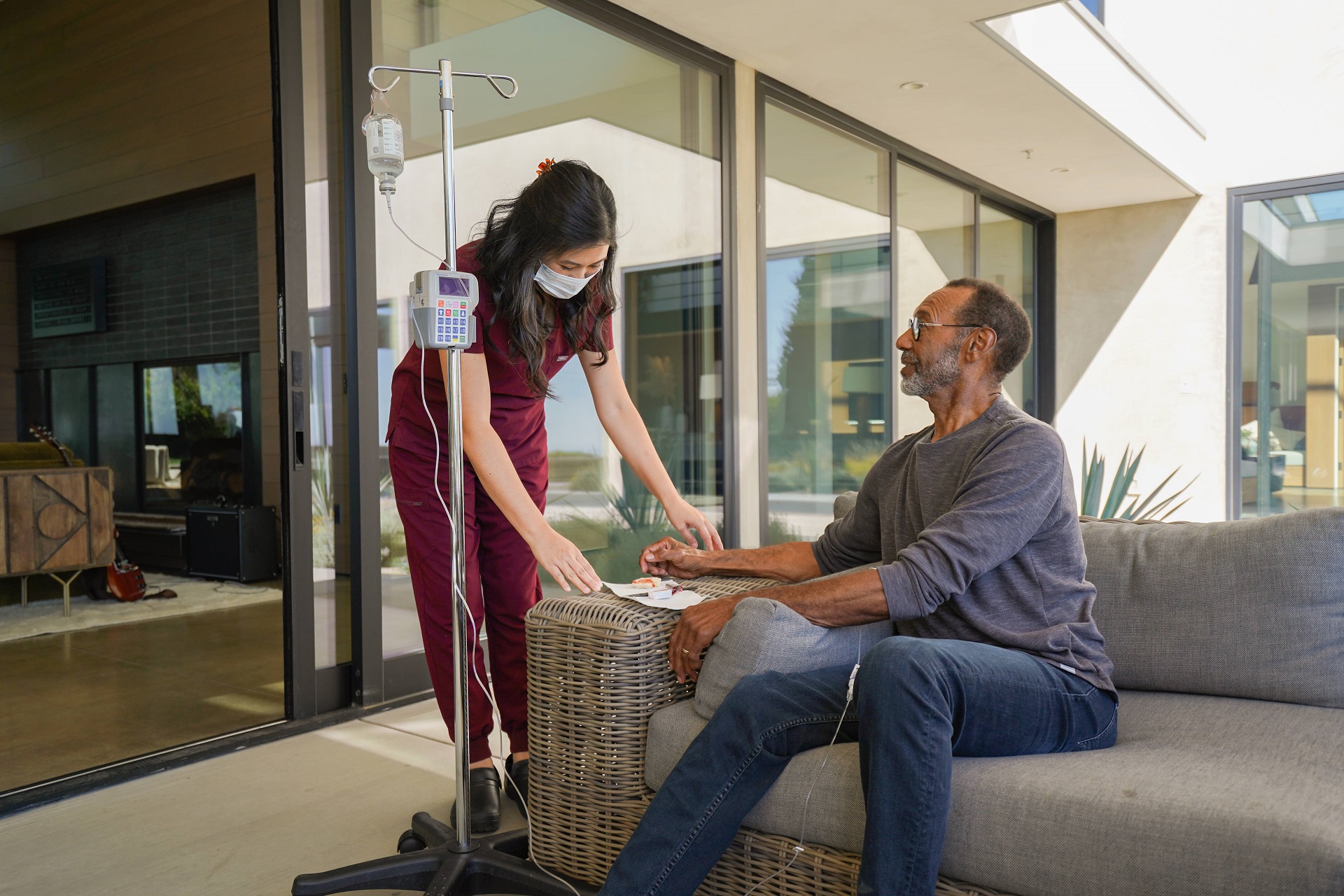
免疫细胞产生抗体,这是一种特殊的蛋白质,有助于中和和清除外来病原体。抗体也称为免疫球蛋白 (Ig)。免疫球蛋白专门与其他细胞的特定区域结合,就像锁和钥匙一样。免疫球蛋白在血液中不断循环,寻找可结合的外来细胞。免疫球蛋白可以在献血过程中从健康献血者体内提取,与其他血液成分分离,然后通过静脉注射给有需要的患者。这种治疗方法被称为 静脉注射免疫球蛋白(IVIG)多年来,IVIG 一直是 FDA 批准用于治疗各种疾病的疗法。然而,与任何其他医疗手段一样,IVIG 治疗也存在副作用的风险。许多不良反应较为轻微且可治疗,但在开始治疗前了解 IVIG 疗法的副作用至关重要。
询问 IVIG 家庭输液
IVIG 的生产方法
IVIG 是由数千人捐献的血液混合而成,所有捐献者均已接受筛查。人体内有五种不同类型的免疫球蛋白。IVIG 主要由一种 特异性免疫球蛋白G处理免疫球蛋白以分离 IgG 并准备用于输血大约需要九个月的时间。净化过程对于最大程度减少 IVIG 治疗的副作用至关重要。例如,另一种免疫球蛋白 IgA 会引起过敏反应,因此需要从池中去除。该过程还旨在去除可能导致 IVIG 治疗副作用的稳定剂和防腐剂。IVIG 经过广泛处理以灭活 HIV 以及乙肝和丙肝病毒等病原体。其中包括纳滤、低 pH 处理、热处理和其他程序。由于免疫球蛋白天然具有的免疫功能,这也降低了任何传染性病毒在生产过程中存活并接触接受者的可能性。
静脉注射免疫球蛋白 (IVIG) 的工作原理
了解静脉注射免疫球蛋白(IVIG)的工作原理有助于您理解IVIG治疗的副作用。IVIG的主要用途之一是保护免疫抑制患者免受感染。IVIG也可用于治疗自身免疫性疾病,即免疫系统错误地攻击自身细胞。IVIG治疗的副作用在患有多种疾病的人群中更为常见。 免疫球蛋白 具有自动免疫效应,无需主动免疫细胞复制。因此,它们可以静脉注射给免疫系统受到抑制的人,例如 低丙种球蛋白血症 或者 IgG缺乏症,以保护它们免受感染。然而,IVIG治疗中这种突然激活的免疫效应可能会引起肌肉疼痛和发冷等副作用。IVIG还具有抗炎和免疫调节特性。免疫球蛋白可能有助于阻止其他免疫细胞的成熟,或干扰促进免疫效应的信号,从而有助于舒缓免疫系统,并最大限度地减少其在自身免疫性疾病(例如 格林-巴利综合征 或者 慢性炎症性脱髓鞘性多发性神经病.
IVIG 的剂量和给药方法
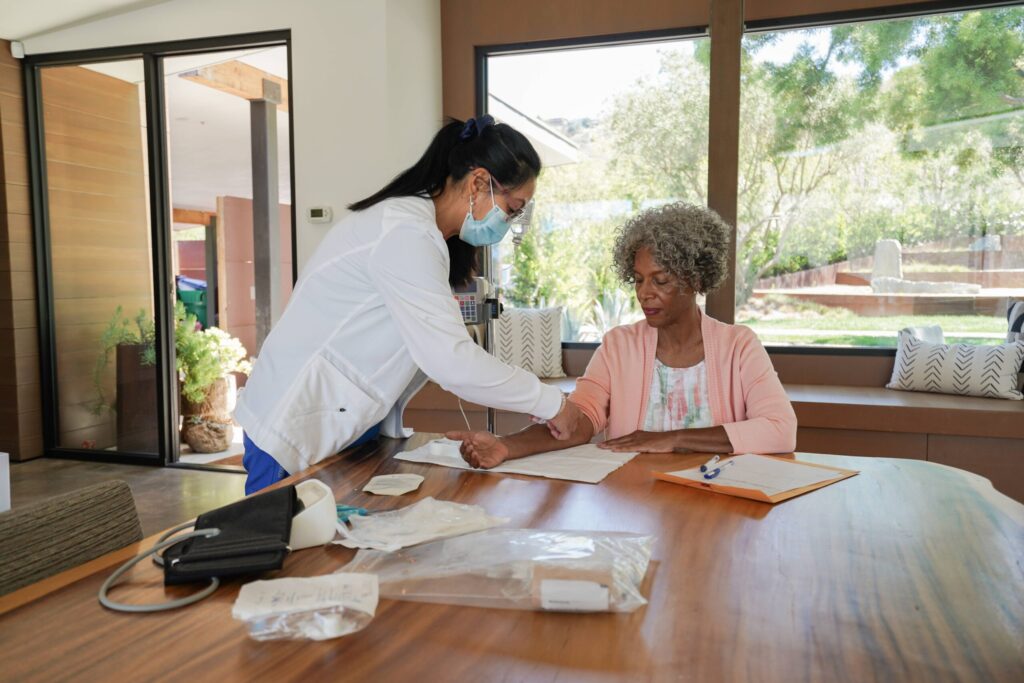
IVIG 的剂量各不相同,取决于其所治疗的疾病。虽然剂量因疾病而异,但始终基于体重。IVIG 治疗剂量越大,副作用发生的可能性就越大。如果患者在 IVIG 治疗中出现严重的副作用,则可在后续治疗中使用较小剂量。输注速度越快,副作用发生的可能性也就越大。只需降低输注速度即可有效降低副作用的风险或严重程度。IVIG 也需在低温下保存以延长其保质期。输注前,将其升温至室温,有助于减少副作用。首次输注通常在医疗机构进行,有经验丰富的医疗专业人员随时待命,以处理 IVIG 治疗的任何副作用。然而, 在家中进行 IVIG 输注 由专门的输液护士进行。免疫球蛋白通常在体内停留2至6周,但具体时间因病情和个体而异。
获得 IVIG 共同支付援助
IVIG 财务援助IVIG 治疗的轻微副作用
大多数静脉注射免疫球蛋白(IVIG)的副作用在开始输注后不久就会显现。泰诺和非甾体类抗炎药(NSAID),例如美林(Motrin)或苯海拉明(Benadryl),可用于快速治疗大多数反应,因为它们症状轻微、短暂且可治愈。有时,只需停止输注,待症状消退后再重新开始即可。患者在首次治疗时更容易出现症状。IVIG治疗最常见的副作用是 头痛但也可能会出现寒战、潮红、疲劳、肌肉酸痛和腹痛。这些症状可能是输注的副作用,也可能是由潜在感染引起的,感染会导致输注的免疫球蛋白激活免疫系统,并释放信号,引发典型的流感样症状。如果出现症状,可以停止治疗,以检查是否存在隐性感染,这些感染最常发生在鼻窦和肺部。否则,只需对症治疗即可。
IVIG治疗的严重副作用
虽然IVIG治疗可能出现严重副作用,但这些副作用极其罕见。与轻微副作用类似,更危险的反应通常会在开始治疗后立即出现或几小时内出现。这些副作用也更有可能在初始治疗期间或IVIG产品更换后出现。接受IVIG治疗后可能出现的一种反应是过敏反应。过敏反应是一种严重的过敏反应,可能导致呼吸道肿胀、荨麻疹、呕吐、低血压,甚至死亡。最常见的原因是: IgA 缺乏症 可通过停止输注并注射肾上腺素来治疗。由于近年来生产工艺的改进,静脉注射免疫球蛋白(IVIG)引起的过敏反应如今已极为罕见。IVIG治疗的其他可能但罕见的副作用包括输血相关循环超负荷 (TACO) 和输血相关肺损伤 (TRALI)。这两种情况都可能导致呼吸窘迫。减缓输注速度、减少盐浓度的溶液以及添加利尿剂以帮助患者排出多余的液体都是治疗TACO的可能方法。TRALI的治疗方法是立即停止输注并提供呼吸支持。
IVIG 治疗的长期副作用
IVIG 可能与一些 长期或延迟影响 治疗后。静脉注射免疫球蛋白(IVIG)接受者可能面临更高的血栓风险。患有其他疾病(例如癌症、雌激素治疗、制动以及某些遗传性结缔组织疾病)的人,血栓风险更高,因为这些疾病会增加血栓形成的风险。反复接受IVIG治疗的另一个可能的副作用是肾脏损伤,尽管这种情况很少见。老年人群(65岁及以上)以及已有肾脏疾病的人面临更高的风险。这种易感性增加可能是由于IVIG治疗中存在糖分,或红细胞在与输注的免疫球蛋白相互作用后会释放毒性残留物。当大量红细胞被破坏时,IVIG偶尔会导致贫血。因此,如果接受IVIG治疗的人出现苍白、疲劳或虚弱等症状,则可能需要在输血后几天进行贫血检测。IVIG治疗几天后,也可能出现湿疹反应的副作用。
使用 IVIG 安排疫苗接种
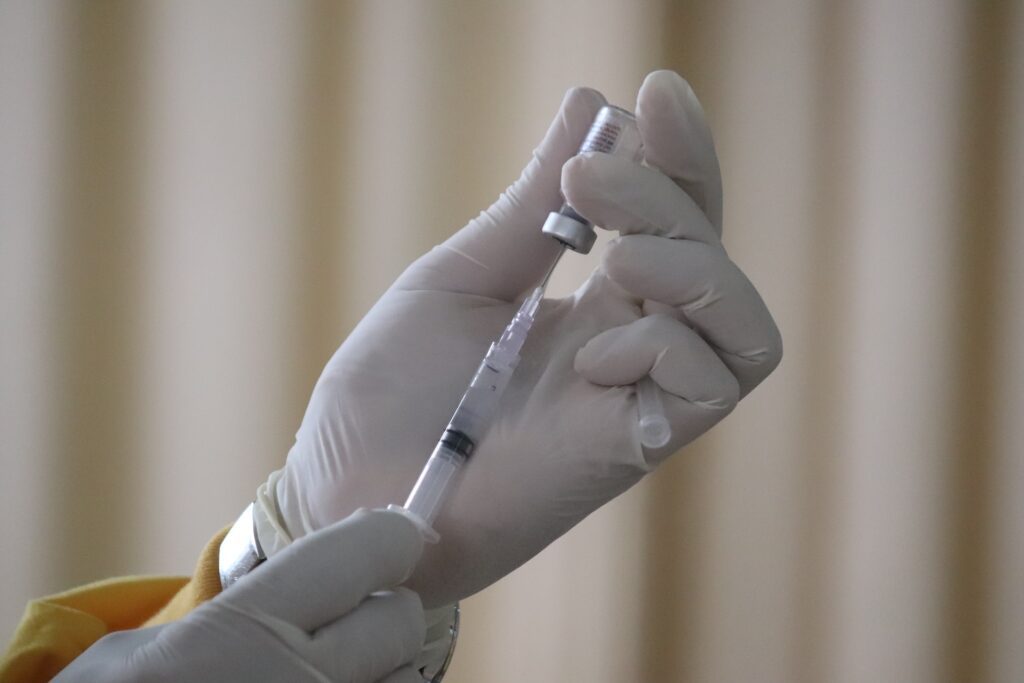
活疫苗免疫反应下降是IVIG疗法已知的副作用。活疫苗会引入一种病毒,这种病毒可以在体内复制并引发免疫反应,但其毒性太弱,无法感染人体。输入的免疫球蛋白可能会阻止病毒复制,从而阻止人体产生足够的免疫反应。为了确保足够的免疫反应和保护力,IVIG疗法后不应立即接种活疫苗。疫苗接种时间表各不相同,但通常两次接种之间会间隔几个月。
治疗信息
获得 IVIG 事先授权如何最大程度减少 IVIG 治疗的副作用
降低IVIG治疗副作用风险最简单的方法之一是在开始治疗前充分补充水分。这可以通过在IVIG输注前几天大量饮水来实现。通常无需预先用药,但有头痛病史的患者可以服用非甾体抗炎药(NSAID)或泰诺。对于之前接受IVIG治疗后出现瘙痒、恶心、发冷或肌肉酸痛的患者,泰诺或苯海拉明的预先用药也可能有帮助。然而,这些症状通常会随着时间的推移自行消退。值得注意的是,不同的IVIG制造商可能使用不同的输注技术。有时,更换不同的IVIG产品可能有助于预防IVIG治疗副作用的复发。如果患者之前接受过某个品牌的IVIG产品并且耐受性良好,则不建议更换其他产品。
使用 AmeriPharma® Speciality 在家接受 IVIG
如果你需要 IVIG治疗AmeriPharma® Specialty 可以为您提供帮助。我们持有美国 40 多个州和地区的专科药房执照,并获得 URAC 和 ACHC 认证。凭借 20 多年的 IVIG 输液管理经验,我们拥有将 IVIG 疗法副作用降至最低所需的专业知识。为了给您提供治疗,我们会派一位训练有素的输液护士上门服务。 AmeriPharma® 专业药房,我们致力于减轻您的治疗负担。我们不仅提供 家庭输液,而且还有助于 保险审批 和 共同支付援助 降低您的治疗费用。请致电 (877) 778-0318 联系我们,与患者权益倡导者讨论治疗方案,或咨询执业药剂师。AmeriPharma® 专科医生可以立即为您提供帮助。


